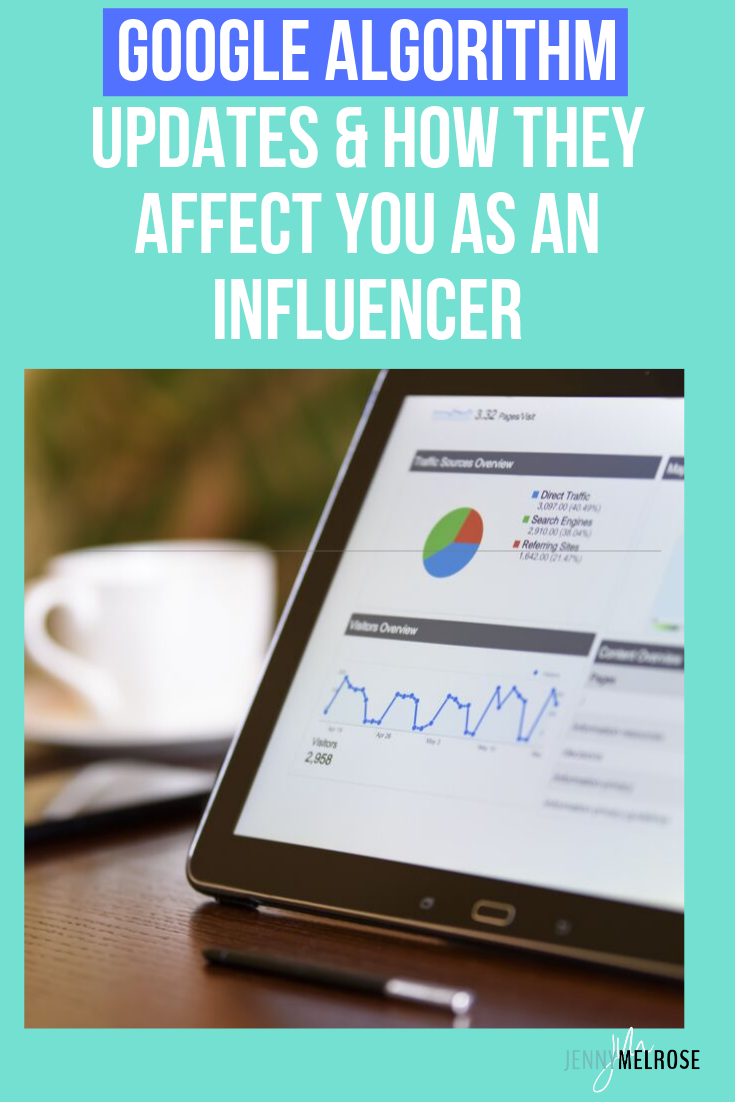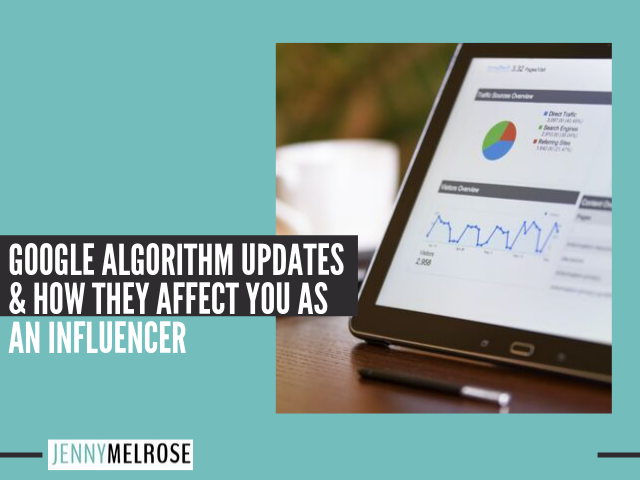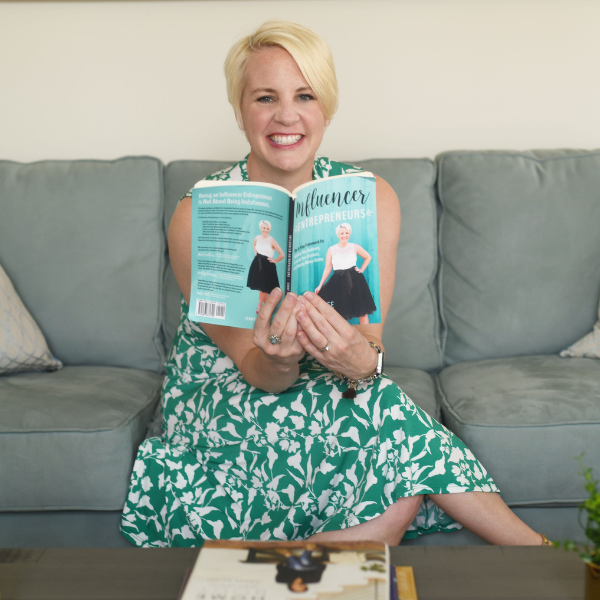The recent Google algorithm updates have many people worried about why their traffic dropped, but it comes down to E.A.T. (Expertise, Authority, Trust).
IE 143: Google Algorithm Updates and How they Effect You as an Influencer with Marye Audet-White

I am super excited about today’s guest on the podcast. Marye Audet-White was on here with me way back in episode 67, when we talked about her course, Search Engine Seduction. It’s been a long time and a lot has changed since then when it comes to SEO, so I asked Marye to come back and update us all.
Marye has been blogging for several years at her Southern food blog, Restless Chipotle.
Because of her knowledge regarding SEO, I strongly encouraged Marye to create some courses on the topic.
Her courses, Search Engine Seduction, her membership site, Own It, Darling, her mastermind group, Search Engine Seduction Mastermind, and her website, Mary Audet-White are all designed to help women who are too busy to learn everything about tech speak but still want to understand SEO.
Using Alt-Text Correctly on Images
One of the biggest changes in the last year is voice recognition. It changes everything, not just search. As of right now, you have to pay Amazon to put your blog on Alexa for Google Search.
With Google, you have to have a site that is set up for artificial intelligence readers. This means the alt-text on your images need to be actual alt-tags.
For example, your alt-text could say “chocolate cake on a white plate with title text overlay.”
We’re really proud of our images when they turn out amazing. However, it can be hard to alt-tag these images without it getting confusing because they have so many things happening, or because they are redundant.
The best thing you can do is to use your process shots on your blog (if you are a food blogger, making that chocolate cake, then all your process shots would be of cracking eggs, whisking, stirring, etc… easy to alt-tag).
Then you can use that great winning image to create a pin. If you have 12 great images, you can create 12 pins and release one a month. This makes both Pinterest and your blog happy.
If you really want to use one of your beautiful images on your blog, make sure you leave the alt-tag blank.
All of these images and their alt-tags will go into what Google is going to consider high-quality content for artificial intelligence. This works whether you are a food blogger, DIY home decor blogger, or anything else.
The Discover Box
Google has a new feature called Discover.
When you search something, there are usually a few things that pop up: images or video, then the search results, and then a box called Discover. Your goal is to get in the Discover box.
The more boxes you are in, the more chance you have of people seeing you and clicking on your site. You can actually find this in your Google Analytics, and it will tell you how many clicks you have gotten to your site from the Discover box.
How do we get into the Discover box? It all comes down to high-quality content with the best user experience.
Expertise, Authority, and Trust
We’ve all heard of the importance of E.A.T.: Expertise, Authority, and Trust.
These 3 things are going to be the battle cry of bloggers forever. Google really doesn’t hate you; they want to give their readers the best experience they can so that they make money.
If you get on board with Google and are helping them make a good income, they will help you out and you will rank higher. Marye has an E.A.T. cheat sheet to help you out in this area. Add link to cheatsheet.
Expertise
Expertise is all about the credentials you have as an author.
Do you have a degree, relevant experience, or work experience? You don’t have to have a degree to be a parenting blogger, because you are your own expert.
You are sharing things from your life. You are an expert in yourself. If you do have a degree or relevant/work experience, make sure that information is in your bio.
Make sure you have a LinkedIn profile set up. This is a bio in and of itself. We talked about LinkedIn in an episode a few weeks ago, so if you need any tips or tricks go back and give that a listen.
Make sure your bio is showing in all of your posts. Link to your About page. On most blog themes, there is a way to have your bio show up at the bottom of your page.
Your site’s expertise is all about where you have been quoted, the site has been mentioned, any incoming links from bigger sites, or sponsors you have worked with.
If you work with a large brand, they are saying that you are an expert. Google sees that brand as an expert, so now Google sees you as an expert by association. It’s that simple.
Authority
Authority for the author is about how high-quality is your content? How is your grammar? Do your posts read smoothly? You should be giving factual information that sounds like you know what you’re talking about.
For your site, this will come in the form of reviews of your site and what people are saying about it. This means recipe reviews, Google reviews, Facebook page reviews, and testimonials.
Trustworthiness
What is your reputation around the web?
Google knows your name and so there doesn’t have to be a link back to your bio for them to be able to find you. One thing you do want to do is conduct searches for your name and your blog name to make sure that everything said about you is positive and strong.
Places you are quoted also builds trustworthiness. When you’re quoted by people that Google considers trustworthy, just like with expertise, you will be considered trustworthy by association.
You absolutely need to be sure that your site is secure and that you have an About page with the area of the country (or the world) where you are located.
Make sure it’s obvious that you’re a real person and you have an easily accessible email address. Update your About page regularly.
Add to Your Expertise
Marye gets lots of questions about whether or not bloggers should work with publishing companies (normally Calysto).
There are cons: you don’t get paid very much, you only have 5 weeks to finish the book, etc. But being a published author with your name on a book, (or several books) proves expertise. It’s so good for you and your business.
If you get the chance to write a book, do it. This gives you more credibility as well as more pages on the web. Marye has an author page on Barnes and Noble, Amazon, and so many other sites.
Anything you can do that shows your audience that someone thinks you’re an expert is what you want to do. And when you do those things, make sure they are super high-quality, because that is what gets good reviews.
No-follow Links
Things have changed as far as no-follow links. When you do a sponsored post, links are supposed to be no-follow links. Here’s what you will do from now on:
- Instead of writing rel=”nofollow”, you will write rel=“sponsored.” You will use this if you are being compensated for a product or using an affiliate or have been paid to put together a recipe, etc…anything where you would have benefited from the post in a material way.
Several years ago, WordPress came out with “no-referrer” to the code. Amazon didn’t like that, because it didn’t allow them to know where people were coming from and it was against Amazon TOS.
Amazon overlooked it for years, but when Google changed this code, it took away the problem.
Always put “sponsored” into the place where you would put “no-follow”. And no, you don’t have to go and fix all of your links from past posts.
If you are linking to a site that has good information but you’re not sure if it’s a trustworthy site, you will use a no-follow link there. This allows you to quote the site without aligning yourself with it.
Make Your Posts Different
In the past, you would go into your search consul and see what you were ranking for in keywords. If you had a post that said “fried potatoes” that was ranking well, you might do a post that was keyworded “pan-fried potatoes” next.
Google is now saying that those two keywords are too close, and they will only rank you for one of them. Instead of doing two different post for your fried and pan-fried potatoes, just have the instructions for both on one post.
These are all things we can easily implement. Marye is great at giving examples and putting the tech-speak into terms we can all understand. Make sure you grab her freebie and are putting E.A.T. into place in your sites.
And be sure you listen in to the entire episode because Marye shared so much information that we couldn’t include in this post!
Action Steps:
- If you liked this episode of Influencer Entrepreneurs, please subscribe and leave a fabulous review!
- Check IGTV for episodes never seen anywhere else.
- Join the conversation on Instagram by tagging Jenny when you’re listening to the podcast. She’ll send you a personal message whenever you tag her.



Great article can’t wait to listen to the Podcast. However I have a question related to alt tags on pictures. I thought each picture should have alt text but she is recommending not to put alt text on our hero images and only in our process shots? That would not be helpful for someone using a screen reader. Can you expand on that please?
You are correct. You want to use alt text so that those using a screen reader know what it is a picture of, but if you’re hero image does not make sense within the context of describing it then you would leave it off because it can be seen as keyword stuffing rather than helpful.